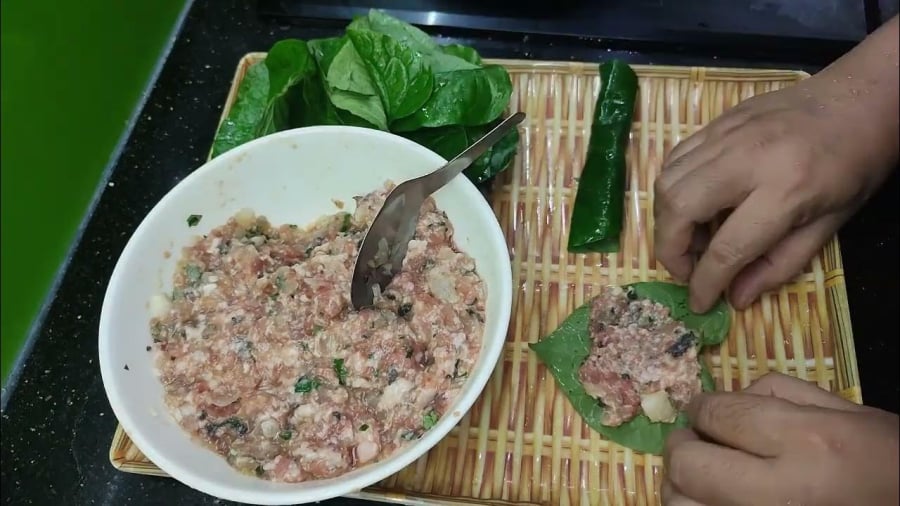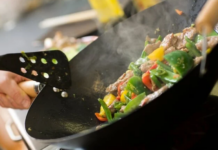Many home cooks have a habit of frying betel leaves, resulting in a blackened and unappealing appearance. So, what’s the secret to achieving a delicious and visually appealing betel leaf dish with a mouthwatering aroma?
Let’s find out!

1. Why Do Betel Leaves Turn Black and Fragile During Frying?
The main reasons are as follows:
- Insufficiently hot oil leads to prolonged cooking time, causing the leaves to absorb moisture and turn black.
- Wet leaves, not thoroughly dried, cause oil splatter and result in soft, fragile leaves during frying.
- Rough handling during flipping can easily tear the leaves.
- Insufficient oil and high heat cause the rolls to burn on the outside while remaining undercooked inside.
- Improper meat marination leads to a loose filling, making it challenging to maintain the shape of the rolls.
2. Four Steps to Delicious Betel Leaf Rolls with Intact, Green Leaves
Step 1: Properly Prepare the Betel Leaves
- Select fresh, pest-free, and undamaged betel leaves. Opt for leaves that are neither too young nor too old.
- Gently wash and soak them in a dilute salt solution for 5 minutes, then let them air dry.
- Use a clean cloth or paper towel to thoroughly dry each leaf before wrapping.
☘️ Note: The drier the leaves, the better they will hold up during frying, retaining their attractive green color.
Step 2: Create a Flavorful and Cohesive Filling
- Use a mixture of ground meat with some fat; an ideal ratio of lean meat to fat is 7:3 to prevent dryness.
- Enhance the flavor with chopped shallots, garlic, black pepper, fish sauce, a touch of MSG, and finely chopped pork fat for added richness.
- Mix thoroughly and let the mixture rest for 15 minutes to allow the flavors to meld.

Step 3: Skillfully Wrap the Rolls, Exposing the Green Side of the Leaves
- Place the darker green side of the leaf facing outwards, with the lighter side facing in. This ensures that the more attractive side of the leaf comes into direct contact with the oil during frying.
- Securely wrap the rolls, ensuring they are not too large for even cooking.
Step 4: Fry with Precision to Avoid Discoloration and Breakage
- Heat a generous amount of oil in a pan.
- Once the oil reaches a moderate temperature (around 160-170°C), carefully place the rolls in the pan.
- Fry over medium heat, gently flipping to avoid breaking the leaves or tearing the rolls.
- When the exterior turns slightly crisp and the leaves darken in color, flip them over.
- Remove the rolls from the oil and place them on a paper towel to absorb excess oil. They are best served hot.

3. Tips for Maintaining the Freshness and Aroma of the Rolls
- If you’re not serving the rolls immediately, allow them to cool and store them in an airtight container. Reheat by frying briefly in a small amount of oil to restore their crispness.
- For larger batches, you can partially fry the rolls and then freeze them. When needed, simply thaw and fry again to achieve the same delicious results as freshly made rolls.
Betel leaf rolls are not just a nostalgic taste of home but also a versatile dish that pairs well with rice and appeals to both adults and children. Don’t let this seemingly simple dish become a kitchen nightmare due to blackened, dry, or torn leaves.
With a few subtle adjustments to your frying technique, as outlined above, you can ensure that your betel leaf rolls are fragrant, crisp, and mouthwatering, rivaling those served in restaurants!
Do you frequently prepare betel leaf rolls? Have you ever encountered the issue of blackened leaves during frying? Share your tips and tricks to elevate this humble dish and make it a delightful part of your daily meals!
The Ultimate Guide to Making Delicious, Chewy Coconut Jam for Tet 2025: A Delectable Treat!
Coconut jam, especially young coconut jam, is an indispensable delicacy during the Tet holiday in Vietnam. This sweet treat is a traditional favorite and a must-have for any host wanting to impress their guests. With a simple recipe, you can easily create this delicious delicacy at home and bring a taste of tradition to your table.




































